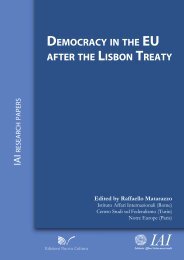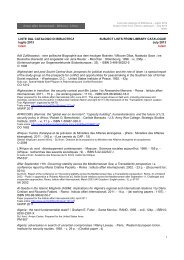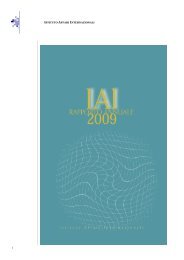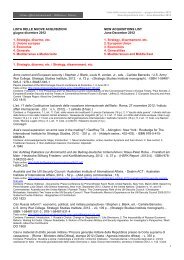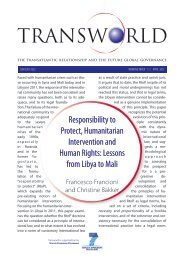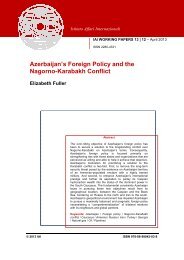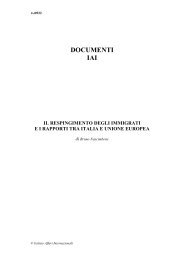Paper - IAI - Istituto Affari Internazionali
Paper - IAI - Istituto Affari Internazionali
Paper - IAI - Istituto Affari Internazionali
Create successful ePaper yourself
Turn your PDF publications into a flip-book with our unique Google optimized e-Paper software.
<strong>IAI</strong>0909<br />
Like previous treaties, the 2008 Treaty is in Italian and Arabic. Both texts are authentic.<br />
The Treaty is an ambitious document emphasizing the “special and privileged”<br />
relationship that the two countries intend to develop, without forgetting the roles that<br />
they pursue, respectively, in the European Union and the African Union.<br />
The Treaty is made up of three parts: general principles; closing with the past and<br />
ending the disputes; partnership. It begins with a long preamble which sets down,<br />
among other things, the will to close with the “painful ‘chapter of the past’ for which<br />
Italy has already expressed its regret for the suffering that Italian colonization caused<br />
the Libyan people”. In short, Libya has managed to receive a “condemnation” of Italian<br />
colonialism, which is reflected in several of the Treaty’s provisions. The reference to<br />
regional cooperation is also significant. This is attested to by the negotiations for a<br />
framework agreement between the European Union and Libya which started in<br />
November 2008.<br />
A good part of the section dedicated to the principles repeats norms deriving from<br />
international customary law or the UN Charter, to which the Treaty constantly refers:<br />
respect for sovereign equality, prohibition of the threat or use of force, non interference<br />
in internal affairs, respect for human rights and fundamental freedoms.<br />
But some clauses are not that “neutral”. For example, the prohibition to carry out hostile<br />
acts that set out from the respective territories triggered speculation in the media that<br />
this was incompatible with Italy’s membership in NATO. Actually, this is not a “nonaggression”<br />
pact and it is therefore not incompatible with the NATO Treaty, should<br />
Libya act outside of “international legality” as laid down in the provision. Nevertheless,<br />
more complex instances can be envisaged and problems could arise should the US fleet,<br />
after leaving bases in Italy, navigate in the Gulf of Sidra to reassert the freedom of the<br />
high seas. The reference to international law at the beginning of the provision is meant<br />
to protect operations in self-defense or under UN authorization that set out from Italian<br />
territory.<br />
The notion of “international legality”, an unusual expression for diplomatic documents,<br />
is repeated in the last provision of the Treaty and constitutes the framework in which the<br />
relations between the two countries are to unfold. Another interesting provision is the<br />
one on human rights and fundamental freedoms contained in Art. 6, which refers to Art.<br />
14 of the Universal Declaration of Human Rights. The reference to the Declaration and<br />
to the UN Charter is supposed to allow Italy to ask for their respect, even though the<br />
Declaration is not a legally binding instrument.<br />
Also worthy of mention is the third paragraph of Art. 19, which commits the parties to<br />
collaborating to prevent illegal immigration in the countries of origin of the migratory<br />
flows through bilateral and regional initiatives. Among other things, Libya is a party to<br />
all the most important international human rights treaties, with the exception of the<br />
1951 Convention on Refugees, as well as being party to the 1981 African Charter on<br />
Human and People’s Rights, which contains provisions on the treatment of foreigners.<br />
© <strong>Istituto</strong> <strong>Affari</strong> <strong>Internazionali</strong><br />
4





